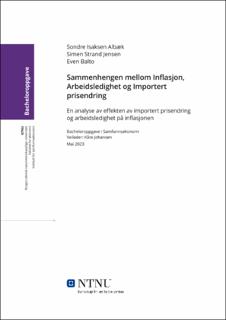| dc.description.abstract | Flere vestlige land har opplevd sine høyeste inflasjonstall på flere tiår. Sentralbanker over hele verden har som en følge av dette satt opp styringsrentene i et forsøk på å presse ned inflasjonen gjennom blant annet økt arbeidsledighet. Samtidig argumenterer flere for at veksten i importert prisendring har en betydelig effekt på inflasjonen. Denne oppgaven ønsker å undersøke hvor stor påvirkning arbeidsledigheten og importerte prisendringer har på den innenlandske inflasjonen i Norge. Oppgaven benytter tidsseriedata fra januar 2018 til januar 2023. Regresjonsmodellen utvides trinnvis ved inkludering av en og en variabel for å undersøke den isolerte effekten de to forklaringsvariablene har på inflasjonen.
I vår første modell finner vi statistisk signifikante resultater for at arbeidsledigheten har en negativ avtagende påvirkning på inflasjonen, frem til vendepunktet. Hovedmodellen vår gir samme resultat, men her er resultatene ikke statistisk signifikante. Videre finner vi statistisk signifikante resultater for at importert inflasjon påvirker inflasjon positivt, og i tillegg er med på å dempe effekten arbeidsledigheten har på inflasjonen.
Nøkkelord: importert inflasjon, inflasjon, arbeidsledighet, tidsseriedata, hypotesetesting | |
| dc.description.abstract | Many western countries experience their highest inflation rates in decades. As a result, the central banks have increased the interest rates in an attempt to decrease the inflation. The increased interest rate affects the labor market through enlarged unemployment, cooling the activity on the market. Alongside the unemployment rates effect on inflation, many argue that the price on imported goods and services, imported inflation, has a significant effect on the domestic inflation. This thesis aims to examine the effects unemployment and imported inflation has on the inflation rates in Norway. To do so, the effects will be examined using time series data from January 2018 to January 2023. The regression models will introduce the variables one at a time, making it easier to isolate the effect of every given variable.
Our first model finds unemployment having a statistically significant effect on the inflation rates. The effect is negative and decreasing, up until the turning point. The main model, which includes both variables as well as a covid dummy-variable gives the same interpretation of unemployment`s effect, only this time not statistically significant. The imported inflation
numbers are, however, statistically significant, having a positive effect on the inflation rates. In addition, including imported inflation as a variable, decreases the effect unemployment has on inflation.
Key Words: imported inflation, inflation, unemployment, time series data, hypothesis testing | |
